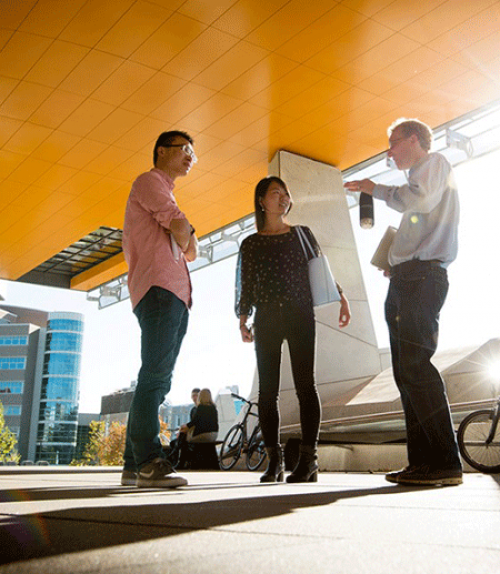More than three years into the provost’s Radical Collaboration initiative, about 15 faculty members have been hired across fields and colleges, partnerships continue to spark research and bold approaches into new areas, and each of the strategic task forces feeding the program has crafted its own approach to the effort.
Provost Michael Kotlikoff launched the initiative in fall 2016 across six cross-college discipline areas, each covered by a faculty task force:
• nanoscale science and microsystems engineering;
• genome biology;
• data science;
• sustainability;
• critical inquiry into value, imagination and culture (CIVIC); and
• infection biology
Digital agriculture was added in early 2019 as a seventh task force and a strategic priority area, and additional investments in the social sciences are envisioned.
By tying Cornell’s interdisciplinary reputation, institutional advantages and broad-based expertise to a multiyear hiring initiative, the effort aims to “allow people to recruit at a higher level into these areas, gets the individuals who come here excited about the collaborative opportunities, and starts them off in that collaborative frame,” Kotlikoff said.
Approximately $60 million is being invested in the ongoing Radical Collaboration initiative over the next several years. These funds will help support faculty startup packages, salaries in some cases and core facilities in others.
Kotlikoff stressed there is no one-size-fits-all approach to the priority areas or to each task force’s strategy. Each group of leading faculty members has been charged with creating its own proposal of investments, methods and goals, which can include targets for hiring; building infrastructure (virtual centers or actual facilities); hosting events, conferences and symposiums; and launching other activities designed to nurture collaborations and generate excitement. Task force updates are available online.
The provost’s initiative “put new wind in the sails of the Cornell Initiative for Digital Agriculture,” said Susan McCouch, Ph.D. ’90, the Barbara McClintock Professor of Plant Breeding and Genetics. She is the director of CIDA and a co-chair of the Digital Agriculture Task Force.
“It helped expand our visibility across the Cornell community,” she said, “and it has sharpened and deepened our efforts to integrate fundamental discoveries across the life sciences, engineering, computing and social sciences as we seek to develop more sustainable agriculture and food systems.”
Paul McEuen, the John A. Newman Professor of Physical Science and director of the Kavli Institute at Cornell for Nanoscale Science, is one of the co-chairs of the Nanoscale Science and Microsystems Engineering Task Force, dubbed “NEXT Nano.” His task force aims to enhance the university’s efforts in nanoscale science – “to strengthen the bones of what was already a very vibrant program,” he said.
Four hires have already been made through NEXT Nano, and “these four people have been really great for us,” McEuen said. “They’ve been fantastic contributors to the university, not only through amazing scientific performance but also with solid leadership that is needed to build centers and collaborative efforts across campus.”
The initiative “has already had a dramatic effect in the area of genome biology,” said John Lis, the Barbara McClintock Professor of Molecular Biology and Genetics and co-chair of the Genome Biology Task Force. The most notable impacts “are in education, core facility infrastructure and the hiring of stellar senior faculty,” he said, adding that a genomics innovation hub now helps share new technologies for use across Cornell’s campuses, and genome biology connections with Weill Cornell Medicine have been strengthened, helping set the stage for “a transformative impact on genomic research at the Ithaca and Weill Cornell Medicine campuses.”
Part of a bigger picture
Kotlikoff stressed that there is a larger, thriving collaborative culture at Cornell outside the formal initiative that remains an essential part of the university’s overall reputation for fostering collaborations and partnerships. The Radical Collaboration investments are part of a broader effort to invest in areas where Cornell leads in research and scholarship.
Just a few recent efforts at that broader level:
• Dr. Gary Koretzky ’78, Cornell’s vice provost for academic integration, and his office is focusing on generating vigorous research collaborations between the Ithaca, Cornell Tech and Weill Cornell Medicine campuses through multi-investigator seed grants, funding that supports intercampus research symposiums, and promoting collaborations.
• The universitywide Global Grand Challenge initiative launched its first multidisciplinary theme, “Migrations.”
• Cornell has a lead role in a multinational project to build the novel-design CCAT-prime telescope in Chile’s Atacama desert, a collaboration at Cornell between the Departments of Astronomy and Physics.
• Last month Kotlikoff announced a new Cornell School of Public Policy, the establishment of “superdepartments” in psychology and sociology, and expansion of the existing economics superdepartment to elevate Cornell’s excellence and prominence in the core social science disciplines.
• The new multicollege Department of Computational Biology will improve coordination, link colleagues across Cornell’s campuses and position it for future growth.
This multicollege department approach – one that also undergirds the new Department of Statistics and Data Science – lets additional colleges and schools add faculty as it grows, thereby building more bridges and expertise between disciplines.
McCouch said one of the founding ideals of the radical collaboration initiative is to “motivate people across the university to look at the world in new ways, to get to know colleagues they have never met before, and to be inspired by new perspectives and ways of thinking.” In her field alone, she said, “it has caused many people to take a new look at agriculture as a complex system that can inspire new frontiers in science, technology, policy and practice."
Read this article in the Cornell Chronicle.




